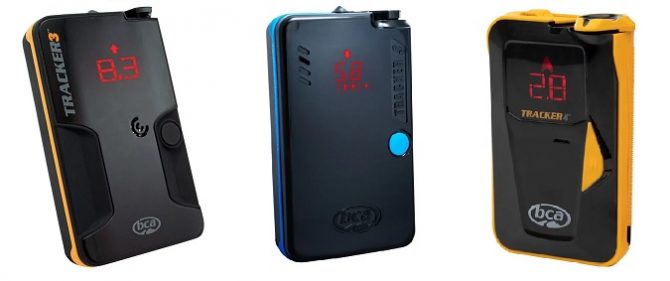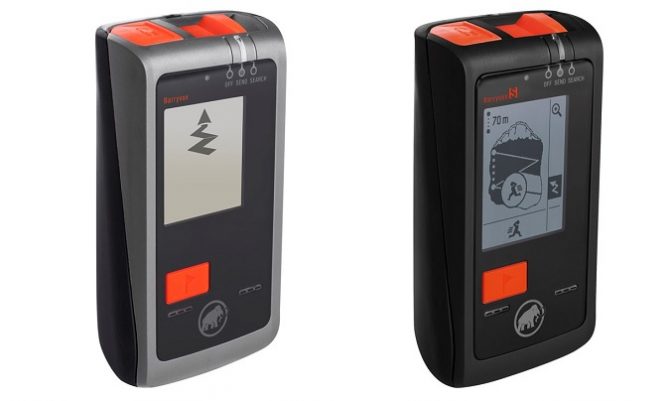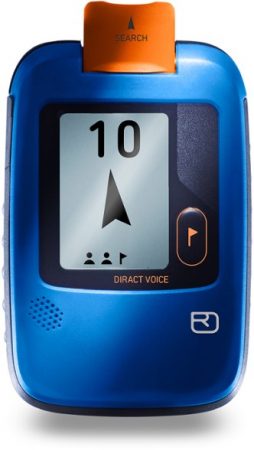
A pair of avalanches near Jones Pass, spotted 12/26. Stay safe out there, friends. Always bring a functional avalanche beacon. Photo: CAIC
Riding the backcountry is joyous and dangerous all at once. Luckily, there’s some great equipment out there to make it safer. The most essential of these items is an avalanche beacon or transceiver. No one should venture into the backcountry without one – nor should they be without buddies to make use of those beacons should disaster strike in the form of an avalanche (or the training in how to use one). Most importantly, you need to be able to trust your beacon to do its thing – not just at the trailhead when you double-check to make sure everything’s working properly, but also when you’ve just been tumbled and carried down the mountain by a couple of tons of fresh snow. There’s been a decent bit of uncertainty about devices currently on the market (more info here and here), so we wanted to bring you a roundup of the devices we use and would stake our lives on, so you can get out there with equipment you can trust.
The Best Avalanche Beacons
Overall Favorite: Backcountry Access Tracker 3 ($350)
Most User-Friendly: Ortovox Diract Voice ($450)
Best for Advanced Users: Mammut Barryvox S ($550)
Best Bang for Buck: Arva Evo 4 ($290)
Competitive Price, Top-Tier Functionality: Black Diamond Recon ($350)
What Features Matter in an Avalanche Beacon?
Transmit-mode revert
All of the below beacons feature an essential safety feature – a time (or motion) delay override to put the beacon from search mode back into transit more. The thought of being buried with my beacon in search mode gives me goosebumps. Imagine searching for a buried pal and then having a second avalanche hit. But this function ensures a searcher who has been buried can be found.
Victim flagging/signal suppression
Another important feature that some of these beacons boast is a flagging or signal suppression function. This allows a searcher to flag a victim as “found” and move on to searching for other people, critical for a multiple-burial scenario.
The two above features are the most important, and what we’d consider to be “must haves” in any beacon we choose to head out into the backcountry with. Other useful features beacons on this list have are bluetooth compatibility for firmware updates and settings customization, “big picture” overviews and robust displays to assist in mass-burial incidents, voice commands, and more.
What Avalanche Beacon Should I Buy?
Overall, any of these ultra-reliable devices would make for a great backcountry companion. My personal recommendation for beginning users would be the Ortovox Diract Voice or BCA Tracker 3. Those looking for a cheaper device will love the Arva Evo 4 or BCA Tracker S. The Mammut Barryvox is a great device for more advanced recreational users who have the knowledge to make use of the extra information provided but don’t want to break the bank on a professional-grade device. For those that do require a pro-level device, you can’t go wrong with the Black Diamond Guide, but the Barryvox S takes the cake with its large screen and high-level search features to go with it.
Without further ado, here’s personal insight into the most trusted avalanche beacons on the market. Feel free to share any of your own experience in the comments below; the larger the communal repository of knowledge, the better. As always, safety first, friends.

The Tracker S, Tracker 3, and Tracker 4 from BCA
Backcountry Access Tracker 3 ($350), Tracker S ($300), and Tracker 4 ($400)
These devices have been the go-to for backcountry users for years. I use the Tracker 3, and my best backcountry buddy has a Tracker 2 that he’s been using since he was a teen and is still going strong, evidence that these sturdy devices can stand the test of time. The Tracker 4, just released this year, brings some new features such as an extra durable exterior and larger display for $40 more. The Tracker S is a slightly less-expensive and slimmed-down option compared to the 3 and 4. All are easy-to-use, boast great battery life and range, can flag victims when searching, and are highly reliable. They also have a motion-sensor auto-revert function to put the device back into transmit-mode if the device doesn’t move for two minutes. The winning feature is their simplicity – BCA’s motto in the beacon category is “Simplicity is Speed,” and these beacons live up to the claim.
Tracker 3 ($350)
CHECK PRICE ON EVOTracker S ($300)
CHECK PRICE ON EVOTracker 4 ($400)
CHECK PRICE ON BackcountryMost User-Friendly: Ortovox Diract Voice ($450)
Ortovox has a long history of making awesome and reliable gear for the backcountry. Senior Editor Joe Carberry has been using an Ortovox 3+ for the past four years and has had no complaints. If you’re considering buying a used beacon, the 3+ (and smaller, cheaper Zoom+) are awesome options, but they’re no longer on the market. New this year, Ortovox debuted their Diract and Diract Voice beacons, and we got our hands on the latter to try out.
The Diract ($390) and Diract Voice ($450) carry on Ortovox’s legacy of simple and intuitive products. Both feature an easy-to-read large display, simple, one-button functionality that’s easy to use with gloves on (and allows for victim-flagging), and rechargeable batteries. The Diract Voice adds voice commands, which are great for beginner users, or anyone who could use a calm voice of reason in a worst-case scenario. The voice commands are actually very helpful, even for advanced users, and not horribly annoying.
Diract Voice ($450)
CHECK PRICE ON REI

Mammut Barryvox and Barryvox S
Best for Advanced Users: Mammut Barryvox ($385) and Barryvox S ($550)
Mammut Barryvox and Barryvox S are both top-of-the-line beacons. The Barryvox S clocks in with a few more details and features for professional rescuers such as an improved flagging system, bigger screen with more information and customizable settings. Both are solid pieces of equipment, and with the highly detailed screen on both devices, you’re able to get a lot more information in multiple victim scenarios than the LED screens on the Ortovox, Arva and BCA devices. That being said, if you’re new to the game, more information isn’t always a good thing, especially in high-stress scenarios such as trying to save a life. Both feature an auto-revert function in case of a second avalanche.
Barryvox ($385)
CHECK PRICE ON EVO Check Price on Amazon
Barryvox S ($550)
CHECK PRICE ON EVO
Arva Evo 4 and Evo 5
Best Bang for Buck: Arva Evo 4 ($290) and Evo 5 ($320)
Similar to the Ortovox Zoom+, the Evo 4 is a slimmed down beacon with all of the functionality you need and nothing that you don’t, but it does have a flagging mode for multiple victims, which the Zoom+ doesn’t. The Evo 5 is, similar to the Tracker 3, a basic and hard-to-mess-up device with simple controls and flagging capability that is light and fits easily in a pocket. At $320, it’s one of the best bang-for-buck devices on the market. The one drawback to Arva devices is their auto-revert function. Other devices use motion sensors and revert back to transmit mode after being motionless for two minutes. Arva devices just go back to transmit mode after eight minutes, annoying for a longer search, and in the case of a second avalanche, the eight-minute delay sounds like a long time indeed to be completely buried under the snow.
Evo 4 ($290)
CHECK PRICE ON EVOEvo 5 ($320)
CHECK PRICE ON EVO
Black Diamond Recon and Guide
Black Diamond Recon ($350) and Guide ($500)
The Black Diamond Recon is, similar to the Barryvox, a top-of-the-line recreational beacon, with the Guide carrying enhanced functionality for professionals similar to the Barryvox S. Both the Recon and the Guide have bluetooth, a rare and useful feature for enhanced customization and information, and the Guide even has an inclinometer to measure incline angle, a useful feature for anyone. But it carries a hefty price tag with it. Both have flagging capability for multiple victims and auto-revert in case of a second avalanche.
Recon ($350)
CHECK PRICE ON EVO CHECK PRICE ON Black Diamond
Guide ($500)
CHECK PRICE ON BackcountryEditor’s Note: For more gear reviews and features on The Inertia, click here.


